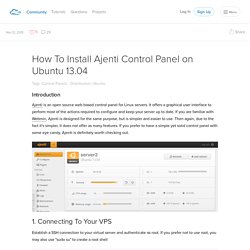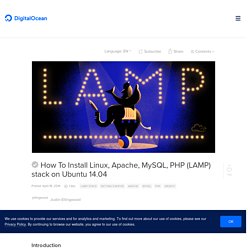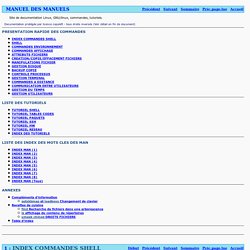

10 Essential Open Source Security Tools. There are thousands of open source security tools with both defensive and offensive security capabilities.

The following are 10 essential security tools that will help you to secure your systems and networks. These open source security tools have been given the essential rating due to the fact that they are effective, well supported and easy to start getting value from. 1. Nmap - map your network and ports with the number one port scanning tool. Nmap now features powerful NSE scripts that can detect vulnerabilities, misconfiguration and security related information around network services.
How To Install Ajenti Control Panel on Ubuntu 13.04. Introduction Ajenti is an open source web based control panel for Linux servers.

It offers a graphical user interface to perform most of the actions required to configure and keep your server up to date. If you are familiar with Webmin, Ajenti is designed for the same purpose, but is simpler and easier to use. Then again, due to the fact it's simpler, it does not offer as many features. If you prefer to have a simple yet solid control panel with some eye candy, Ajenti is definitely worth checking out. 1.
Establish a SSH connection to your virtual server and authenticate as root. Ssh root@your-ip Download the latest package files: apt-get update 2. 2.1. The repository key is used to validate that the package originates from the legitimate source, thus preventing the installation of possibly infected packages. The following command downloads the key and automatically adds it to your system. wget -O- | apt-key add - 18 Open Source/Commercial Control Panels to Manage Linux Servers. As an owner of the website it is very difficult to manage multiple websites without a control panel.

However to suit the needs, we need a custom hosting plan. A Web hosting control panel is a totally web-based interface which has capability to manage your web services under a single location. These web based control panels can manage email accounts, FTP accounts, file management functions, creation of subdomains, disk space monitoring, bandwidth monitoring, create backups and many more.
The web hosting control panels provides a elegant solution to Linux newbies to host multiple websites on VPS (Virtual Private Servers) and Dedicated Servers. This kind of hosting panel offers easy to use management software’s to simplifies the process of handling servers without the need of expert knowledge of sever administration.
The most famous and powerful control panels are cPanel and Plesk. Don’t Miss: 12 Control Panels For Virtual Machines (VM’s) Management. How To Install Linux, Apache, MySQL, PHP (LAMP) stack on Ubuntu 14.04. Introduction A "LAMP" stack is a group of open source software that is typically installed together to enable a server to host dynamic websites and web apps.

This term is actually an acronym which represents the Linux operating system, with the Apache web server. The site data is stored in a MySQL database, and dynamic content is processed by PHP. In this guide, we'll get a LAMP stack installed on an Ubuntu 14.04 Droplet. Ubuntu will fulfill our first requirement: a Linux operating system. Note: The LAMP stack can be installed automatically on your Droplet by adding this script to its User Data when launching it. Prerequisites Before you begin with this guide, you should have a separate, non-root user account set up on your server. Step 1: Install Apache The Apache web server is currently the most popular web server in the world, which makes it a great default choice for hosting a website. We can install Apache easily using Ubuntu's package manager, apt. Curl. MANUEL DES MANUELS. La variété des options de 'ls' fait qu'il est très difficile de les présenter toutes dans des exemples concrets.

Ce chapitre a pour objet de présenter les plus courantes. De plus comme 'ls' est certainement une des premières commandes que l'on utilise en débutant, il y aura quelques exemples sur ce que fait vraiment la commande et ce qu'à fait le SHELL avant d'exécuter la commande. Prenons un utilisateur 'dupond' qui est positionné dans son 'home_directory' : '/home/dupond'. Ce répertoire comporte différents sous-répertoires : 'bin' ::= Pour les exécutables propres à cet utilisateur 'sce' ::= Pour les sources propres à cet utilisateur 'data' ::= Pour les fichiers de données propres à cet utilisateur. Il contient aussi : '.profile' ::= Script SHELL exécuté en début de session. L'option '-a' affiche les fichiers commençant par un '.' Dans ce cas l'argument '*' a été substitué, par le SHELL, en liste de tous les fichiers ne commençant par par un ' '.profile' avant le contenu de '.' et de '..'.
Installing on Ubuntu / KB forum / Ajenti.